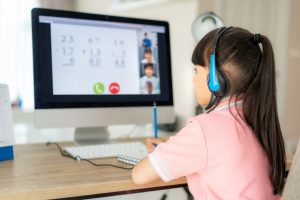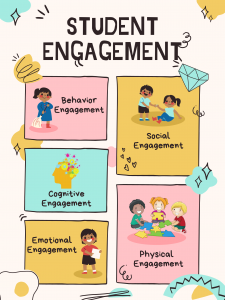TL;DR:
- When we engage students in the curriculum, we need to consider whether we are creating excitement, curiosity, and interest to want to learn more.
- Behavioral, physical, social, emotional, and cognitive are all types of engagement to consider in an educational setting.
Engagement is another word that became overused in 2020. As schools transitioned to remote learning this spring, districts and educators became more focused on and concerned with students who were not ‘engaged’ with learning.
In my school, teachers tracked ‘engagement’ each week. We wanted to determine which students were able to transition to remote learning and which students needed additional support. At this time, transitioning to remote learning was simply whether or not the student was able to connect. We wanted them to log into their newly created Google Classroom, their Zearn account, or iReady account from home. This was a challenge for many students and their families.
What does it mean to be engaged?

Before we get too far into this post, let’s look closely at what it means to be engaged in the context of school and learning.
Engaged as defined by the dictionary means “busy; occupied.” Engage means “occupy, attract or involve (someone’s interest or attention), participate or become involved in.” There are lots of synonyms for the word engaging, but we usually just talk about how engaged or not engaged students are.
Engagement in relation to students is also defined as “meaningful student involvement throughout the learning environment.” This includes the students’ relationships within the school community (with adults, peers, the instruction, and curriculum). We identify student engagement by their positivity, encouragement, and excitement for learning. When we engage students in the curriculum, are we creating excitement, curiosity, and interest to want to learn more?
As I ponder engagement and its various definitions and dimensions, I wonder how we can better engage our students, teachers, families, and community in our classrooms and schools. Share on XEngagement is Multidimensional
You can also look more deeply at engagement and break it down into its multidimensional components of behavioral, physical, social, emotional, and cognitive engagement.
Behavioral Engagement
Behavioral engagement can be seen in the classroom routines or cues that a teacher may use to gain student attention. Call and response is a new strategy some teachers are using effectively to gain students’ attention and refocus them on their learning or tasks. Some teachers will clap, turn the lights off, or use a chime or doorbell. Using a variety of these strategies and not the same one over and over can reduce the monotony and keep kids engaged.
Physical Engagement
Physical engagement may include hands-on and tactile lessons or activities. This may include movement such as holding up a whiteboard with their answer or moving to an area of the classroom. One teacher used the students as parts of a clock to teach time. They would sit in a circle to represent the minutes on the clock and then two students would lay down in the center of the clocks to be the hour and minute hands. Kids got excited about this, especially when two students were asked to lay down to represent 12:00! How are you getting students moving in your classroom? Kids aren’t made to be sedentary for hours at a time.
Social Engagement
Social engagement is an area we have certainly seen a decrease in with remote learning. We are all social creatures and crave that social interaction with others. How are we creating collaborative work opportunities for students in the classroom and virtually? Breakout rooms are a valuable tool for providing these opportunities as well as just giving students a few minutes at the beginning of class to talk.
Emotional Engagement
Emotional engagement is a student’s enthusiasm for their learning as well as having a sense of belonging in their classroom and school. Classrooms need to be a place that students feel part of a community and safe to engage in the learning and lessons. Students who feel like they are a valued part of the classroom will participate more. Students want to have friends, be accepted, and even receive praise from their teachers that they are doing a good job. How are you showing students you value and appreciate them and their work in the classroom?
Cognitive Engagement
Cognitive engagement means students are willing to learn and complete assigned tasks. Do they have the growth mindset needed to persevere and approach an instructional task with a can-do attitude? Are we supporting students so they can persist in activities they find challenging or difficult? Are we giving them the tools and skills they need to work through the productive struggle?
What is your definition of engagement?
As you can see, engagement is not a simple act or easily defined. With this in mind, I ask what is your definition of engagement and how do you measure it? Are you focused on one dimension of student engagement? Are you looking at the various components and how you can use this information to better serve your students?
Engagement can look different depending on what level (early childhood, primary, elementary, middle, high school, or beyond) you’re teaching. These dimensions of engagement will look different in your preschool classroom than they will at the high school level, but none of them are less important at one level than another.
Prior to the pandemic and quick transition to remote teaching, engagement in the classroom was measured by students that were participating in classroom discussions, raising their hand to contribute to conversations, completing a written lesson or turning in homework, doing independent work, contributing to group work, and even completing an exit ticket correctly. This is only a sampling of the plethora of ways that students could demonstrate their engagement with the instruction within the classroom.
Engagement in a Virtual World
Engaging students virtually has become a challenge. Student engagement has decreased drastically across the country. In this setting, through a computer screen, teachers do not have students within an arm’s reach. They can’t tap them on the shoulder, give a nod of the head, read body language, see students working independently, or see their output in real-time. It is difficult to address the different dimensions of engagement when students are far away from you and their classmates. How do you add in movement, collaboration, perseverance, and attention-getters when teaching virtually?
Defining engagement was difficult before we added the challenge of measuring engagement from a distance. But now, is much more difficult through a screen. But engagement continues to be as important as it is challenging.

If we are going to use engagement as a tool to measure student learning, we are going to need to do a better job of defining it. Has your district, school, or team developed their own operational definition of engagement in virtual or hybrid learning? Does it include showing up, completion of work, participation, having cameras on? Have you considered the different dimensions of engagement? There are many variables to consider. Our definitions of engagement may change as we learn more and try new practices. Is your definition of engagement measurable? Can you use this data to drive student achievement?
What does virtual engagement look like?
We had difficulty determining how we were going to quantify student engagement last spring. What we were really trying to determine was whether or not students were being accounted for. We had to determine whether students signing into iReady or Zearn for a specified amount of time would count as being engaged during the week or if they had to sign into a certain number of virtual meetings. We were tracking this ‘engagement’ data in order to reach out to students who were less than 25% engaged. What we were really tracking was whether or not the student was doing something online or if they were on an extended vacation after our two week transition period. We found that many families struggled to transition to online learning.
Fast forward to this fall. Remote learning was becoming the norm. Student engagement became even more important. Engagement was used to measure student learning. We know engaged students are more likely to follow classroom rules, be kind to peers, and be successful in school. Research shows a strong correlation between engagement and student achievement. This is one reason student engagement has become more of a focus with remote learning. Educators are concerned with whether or not students are learning.
[scroll down to keep reading]The Big Conundrum

HOW do we get students to attend and actively involve in remote learning? This is the big conundrum of 2020 (and beyond). Many students are either in school a short amount of time, doing most of their learning on the computer or asynchronously (on their own), or doing all of their school day remotely.
Teaching and learning changed in March of 2020. As an educational leader, I know that teachers need space and permission to try new things. They need to support as they make mistakes. They need encouragment to redesign what doesn’t work. We cannot simply apply traditional teaching strategies to a remote learning world.
I encourage you as the educational leader of your classroom, school, or district to create a consistent and clear definition of student engagement. Consider the various dimensions of engagement and how this will translate to student achievement. Use this definition and data to develop a plan to support students and families, and to drive your professional development.
As I ponder ENGAGEMENT and its various definitions and dimensions, I wonder how we can BETTER ENGAGE our students, teachers, families, and community in our classrooms and schools.
I’m excited to explore and share ideas on how we can all Engage Better throughout this blog series.
About Bobbie French
Bobbie French is an educational leader, presenter, and writer from Massachusetts.
Bobbie has been an educator for over 24 years. She has been an elementary guidance counselor, classroom teacher, special education coordinator, Title I Director, Preschool Director, and Administrator.
Bobbie is passionate about focusing on the whole child and creating an environment where all students have a sense of belonging. She appreciates and recognizes the hard work of teachers, and is committed to supporting others to be their best for kids every day. Her passion and enthusiasm for creating a positive and engaging school culture is contagious.
Bobbie is also an avid photographer and loves to tell her school’s story.




